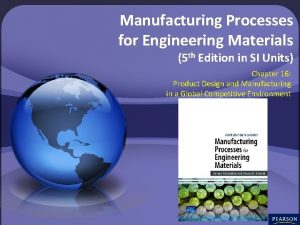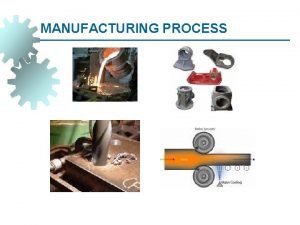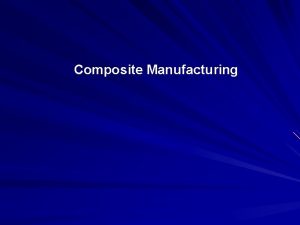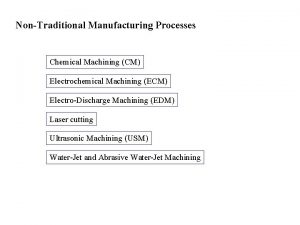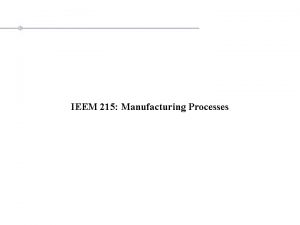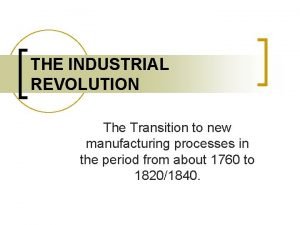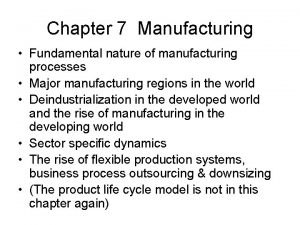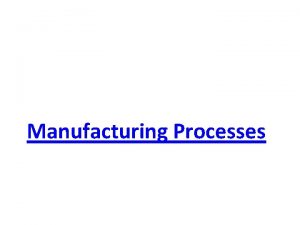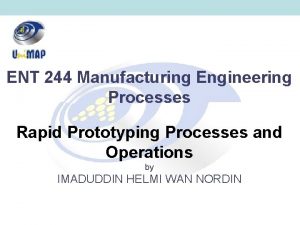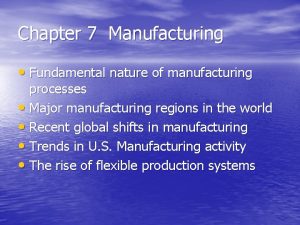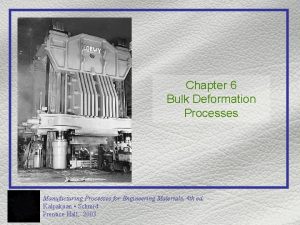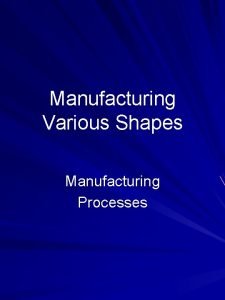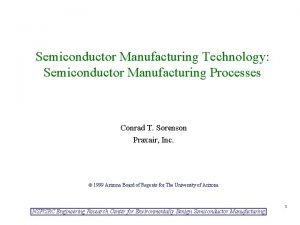The Selection of Manufacturing Engineering Processes CONTENTS CHAPTER


























- Slides: 26

The Selection of Manufacturing Engineering Processes

CONTENTS CHAPTER ONE: Fits and Tolerances CHAPTER TWO: Fundamental of metal cutting CHAPTER THREE: Mechanics of metal cutting CHAPTER FOUR: Tool wear and tool life CHAPTER FIVE: Drilling CHAPTER SIX: Milling CHAPTER SEVEN : Grinding CHAPTER EIGHT: Broaching The Selection of Manufacturing Engineering Process; By Dr. Saied. M. Darwish

CHAPTER SIX : Milling Operation 6 MILLING OPERATIONS CONTENTS The Selection of Manufacturing Engineering Process; By Dr. Saied. M. Darwish

CHAPTER SIX : Milling Operation 6. 1 Milling operation • Milling is a machining operation in which a workpiece is fed past a rotating cylindrical tool with multiple cutting edges. • This cutting tool in milling is known as the milling cutter and the machine tool that traditionally performs the operation is called a milling machine. • Milling is an interrupted cutting operation, the teeth of the milling cutter enter and exit the work during each revolution. The Selection of Manufacturing Engineering Process; By Dr. Saied. M. Darwish

CHAPTER SIX : Milling Operation Figure 6. 1: Conventional face milling with cutting force diagram for Fc, showing the interrupted nature of the milling process. The Selection of Manufacturing Engineering Process; By Dr. Saied. M. Darwish

CHAPTER SIX : Milling Operation 6. 2 Types of milling operations There are two basic types of milling operations: slab/peripheral milling and face milling. 6. 2. 1 Peripheral or slab milling: In this milling operation the axis of tool is parallel to the surface being machined. In this operation there are two opposite directions of rotation that the cutter can have with respect to the work. Figure 6. 2: Peripheral milling operation. The Selection of Manufacturing Engineering Process; By Dr. Saied. M. Darwish

CHAPTER SIX : Milling Operation Figure 6. 3: Peripheral milling operations: (a) slab milling, (b) slotting, (c) side milling, and (d) straddle milling. The Selection of Manufacturing Engineering Process; By Dr. Saied. M. Darwish

CHAPTER SIX : Milling Operation 6. 2. 1. 1 Up milling: In up milling the direction of motion of the cutter teeth is opposite to the feed direction. In this type of milling operation, the chip formed by each cutter tooth starts out very thin and increases in thickness during the sweep of the cutter. The chip length is longer than in down milling. The cutter tends to push the work along and lift it upward from the table, therefore greater clamping force must be employed. In up milling, chips can be carried into the newly machined surface, causing the surface finish to be poorer. . The Selection of Manufacturing Engineering Process; By Dr. Saied. M. Darwish

CHAPTER SIX : Milling Operation 6. 2. 1. 2 Down milling: In down milling, the direction of motion of the cutter teeth is same as the feed direction. In this operation each chip starts out thick and reduces in thickness throughout the cut. The length of the chip in down milling is less than in up milling. This tends to increase tool life. The cutter force direction is downwards, tending to hold the work against the work table. The Selection of Manufacturing Engineering Process; By Dr. Saied. M. Darwish

CHAPTER SIX : Milling Operation Figure 6. 4: Two forms of milling with a 20 -tooth cutter: (a) up milling and (b) down milling. The Selection of Manufacturing Engineering Process; By Dr. Saied. M. Darwish

CHAPTER SIX : Milling Operation 6. 3 Face milling In face milling the axis of the cutter is perpendicular to the surface being milled, as shown in the figure 6. 5. Figure 6. 5: Face milling. The Selection of Manufacturing Engineering Process; By Dr. Saied. M. Darwish

CHAPTER SIX : Milling Operation The Selection of Manufacturing Engineering Process; By Dr. Saied. M. Darwish

CHAPTER SIX : Milling Operation 6. 4 Cutting conditions in milling The cutting speed is determined at the outside diameter of a milling cutter. This can be converted to spindle rotation speed. Where N = spindle speed in rpm V = cutting speed D = diameter of milling cutter The Selection of Manufacturing Engineering Process; By Dr. Saied. M. Darwish

CHAPTER SIX : Milling Operation 6. 5 Chip thickness in milling In face milling the axis of the cutter is perpendicular to the surface being milled, as shown in the figure 6. 5. Figure 6. 7: Chip thickness detail in milling operation. The Selection of Manufacturing Engineering Process; By Dr. Saied. M. Darwish

CHAPTER SIX : Milling Operation The milling operation is characterized by the changing of chip thickness as the cutting proceeds. Therefore the maximum and mean values of chip thickness are to be calculated. Since the chip thickness is an important factor for calculating the cutter forces and power, therefore the maximum and mean values of chip thickness will be calculated. Where Sz = feed of workpiece/tooth = U/(n-z) φe = angle of rotation of milling cutter during which each tooth remains engaged in workpiece material U = feed of workpiece/min. n = rotational speed of cutter in rpm z = number of teeth on cutter since φe is small such that sin φe = φe e = depth of cut, D = outside diameter of milling cutter The Selection of Manufacturing Engineering Process; By Dr. Saied. M. Darwish

CHAPTER SIX : Milling Operation 6. 6 Cutting forces and power in milling the resultant force R acting on a single tooth in peripheral milling operation can be resolved into tangential and radial components (Ps, Pr) or horizontal and vertical components (Ph, Pv). Therefore The Selection of Manufacturing Engineering Process; By Dr. Saied. M. Darwish

CHAPTER SIX : Milling Operation Figure 6. 8: Cutting force components in milling operation. The Selection of Manufacturing Engineering Process; By Dr. Saied. M. Darwish

CHAPTER SIX : Milling Operation 6. 7 The main cutting force “Ps” in peripheral milling h = momentary chip thickness changing from zero to “he” in up milling or from “he” to zero in down milling The Selection of Manufacturing Engineering Process; By Dr. Saied. M. Darwish

CHAPTER SIX : Milling Operation The total mean tangential force is: Where Ze = number of cutting teeth in the same moment The Selection of Manufacturing Engineering Process; By Dr. Saied. M. Darwish

CHAPTER SIX : Milling Operation 6. 8 The cutting power in peripheral milling The main chipping power “Ns” can be calculated as follows: (k. W) The Selection of Manufacturing Engineering Process; By Dr. Saied. M. Darwish

CHAPTER SIX : Milling Operation The feed power “Nf” is given by: (k. W) The total power is: (approximately) (k W) The Selection of Manufacturing Engineering Process; By Dr. Saied. M. Darwish

CHAPTER SIX : Milling Operation 6. 9 Machining time in peripheral milling From figure, it can be noted, Where U = feed of the workpiece per minute The Selection of Manufacturing Engineering Process; By Dr. Saied. M. Darwish

CHAPTER SIX : Milling Operation 6. 10 Material removal rate can be calculated as following: Where L = length of the cut W= width of the cut e = depth of the cut t = machining time The Selection of Manufacturing Engineering Process; By Dr. Saied. M. Darwish

CHAPTER SIX : Milling Operation Problems The Selection of Manufacturing Engineering Process; By Dr. Saied. M. Darwish

CHAPTER SIX : Milling Operation Problems The Selection of Manufacturing Engineering Process; By Dr. Saied. M. Darwish

CHAPTER SIX : Milling Operation Problems The Selection of Manufacturing Engineering Process; By Dr. Saied. M. Darwish
 Manufacturing process for engineering materials
Manufacturing process for engineering materials Manufacturing cost vs non manufacturing cost
Manufacturing cost vs non manufacturing cost Process costing vs job costing
Process costing vs job costing Controllable costs
Controllable costs Manufacturing cost vs non manufacturing cost
Manufacturing cost vs non manufacturing cost Additively
Additively Manufacturing operations can be classified into
Manufacturing operations can be classified into Introduction to manufacturing process
Introduction to manufacturing process Composites manufacturing processes
Composites manufacturing processes Nontraditional manufacturing processes
Nontraditional manufacturing processes Similar
Similar Industrial revolution transition
Industrial revolution transition Nature of manufacturing process
Nature of manufacturing process Concurrent processes are processes that
Concurrent processes are processes that How do geological processes affect evolution
How do geological processes affect evolution How to set up an engineering notebook
How to set up an engineering notebook Balancing selection vs stabilizing selection
Balancing selection vs stabilizing selection Artificial selection vs natural selection
Artificial selection vs natural selection K selected
K selected Natural selection vs artificial selection
Natural selection vs artificial selection Artificial selection vs natural selection
Artificial selection vs natural selection Disruptivr selection
Disruptivr selection K selection r selection
K selection r selection Natural selection vs artificial selection
Natural selection vs artificial selection Two way selection and multiway selection in c
Two way selection and multiway selection in c Multiway selection in c
Multiway selection in c Procedure of pure line selection
Procedure of pure line selection
